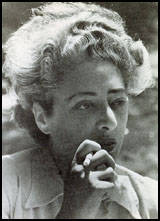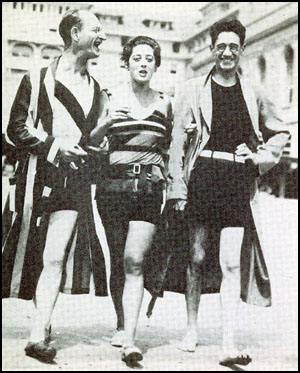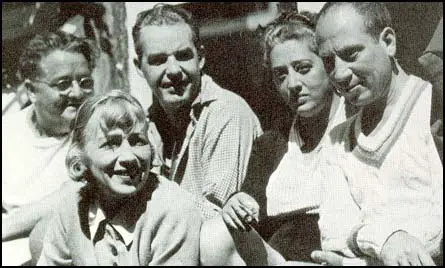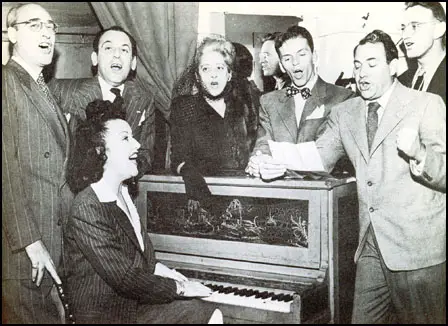Beatrice Kaufman

Beatrice Bakrow, the daughter of Julius Bakrow and Sarah Adler Bakrow, in Oxford Street, Rochester, on 20th January, 1895. According to her biographer, Michael Galchinsky: "She had two brothers, Leonard and Julian. Although few direct references to her Jewishness found their way into her later editorial work and writings, her early life fits the description of upper-middle-class German Jews who thought of themselves as liberal, modern, and forward-looking."
In 1913 Julius Bakrow sent her to Wellesley College but was expelled during her first year for staying out after hours. Her mother met her at the railway station and said: "Beatrice, you've been thrown out of Wellesley. What kind of man will you now?" In 1914 she entered University of Rochester but stayed only a year.
Beatrice Bakrow met the journalist, George S. Kaufman, in 1916, at the wedding of a mutual friend, Allan Friedlich. Howard Teichmann, the author of George S. Kaufman: An Intimate Portrait (1972), claimed that "Bea had developed into one of those large, unattractive girls who compensate for their lack of beauty by being bright, warm, ambitious, stylish, and charming. There was enough charm, enough style, enough ambition, enough warmth, and enough brightness within her to keep him at her side for the entire evening. Like her father, Bea had a full, slow, and rather lazy way of speaking. She did all the talking, and, characteristically, George listened - with interest."
The following day Beatrice and George drove by motor car to Niagara Falls. On her arrival home, Beatrice told her parents that she was going to marry Kaufman. Julius Bakrow objected to her choice when he discovered he was a journalist. "A vehement argument followed, but Bea stood firm and emerged victorious... Her friends in Rochester were astounded. Not only who was George Kaufman but who were his family, what were they, where did they come from, what business were they in, what did he do for a living, and, of course, the ultimate question: how did his future prospects look?"
Kaufman approached his friend, Franklin Pierce Adams, and told him: "Keep the middle of next March open, will you, Frank? I've found a kid upstate who's a peach." Adams, who had observed that the young journalist had never had a girlfriend before, asked: "Are you telling me you're getting married?" Kaufman replied: "Unless it's declared unconstitutional, I am." Adams agreed to be Kaufman's best man at the wedding.

Beatrice and George were married in high-style at the Rochester Country Club on 15th March, 1917. George was too busy with his work at his new post at the New York Times to take a honeymoon. Glancing at the newspapers as they boarded the train that took them back to New York City, George discovered that Tsar Nicholas II had been forced to abdicate. He commented to Beatrice: "Well, it took the Russian Revolution to keep us off the front page."
Beatrice later told a friend: "We were terribly innocent. We were both virgins, which shouldn't happen to anybody." She soon found herself pregnant but unfortunately the child was deformed and stillborn. As their friend, Howard Teichmann, has pointed out: "Beatrice was as crushed as any woman would be, but George's reaction was totally unexpected and heartbreaking to both of them. Following their misfortune, George found himself physically unable to have sexual intercourse with Bea.... There were embarrassed conversations followed by empty promises. First came twin beds, then separate bedrooms, and although George remained Bea's husband, he never again was her lover."
According to Dorothy Michaels Nathan, her friend from childhood, "Beatrice started seeing men even before George started with women." Another friend, the author Alexander King, saw it differently: "Beatrice was one of those great daring women who knows that her husband is having extramarital relations and knows that everybody else knows it, and knows that this can be borne either by throwing fits in lobbies or by being Wife Number One. And she was Wife Number One."
Brian Gallagher, the author of Anything Goes: The Jazz Age of Neysa McMein and her Extravagant Circle of Friends (1987), has argued: "Their lack of sexual experience must have contributed to George's inability to have intercourse with Bea after her miscarriage early in their marriage, and so helped start him on a twenty-year sexual binge... Bea, in the meanwhile, made her own, quite full sexual life, although something of its substitute character is seen in the fact that a majority of the men in it bore a distinct resemblance to George."
Beatrice was determined to establish her own career. At first she was a press agent for three sisters, Constance Talmadge, Norma Talmadge and Natalie Talmadge. Later she worked as a play reader for the Broadway producer, Morris Gest, and as an editor with the publisher, Horace Liveright. It is claimed that she played an important role in discovering and promoting the talent of Clifford Odets, Ernest Hemingway, John Steinbeck, William Faulkner, Djuna Barnes, Bennett Cerf, Oscar Levant, Moss Hart and William Saroyan.
In 1919 George S. Kaufman began taking lunch with a group of young writers in the dining room at the Algonquin Hotel. One of the members, Murdock Pemberton, later recalled that he owner of the hotel, Frank Case, did what he could to encourage this gathering: "From then on we met there nearly every day, sitting in the south-west corner of the room. If more than four or six came, tables could be slid along to take care of the newcomers. we sat in that corner for a good many months... Frank Case, always astute, moved us over to a round table in the middle of the room and supplied free hors d'oeuvre. That, I might add, was no means cement for the gathering at any time... The table grew mainly because we then had common interests. We were all of the theatre or allied trades." Case admitted that he moved them to a central spot at a round table in the Rose Room, so others could watch them enjoy each other's company.
This group eventually became known as the Algonquin Round Table. Other regulars at these lunches included Beatrice Kaufman, Robert E. Sherwood, Dorothy Parker, Robert Benchley, Alexander Woollcott, Heywood Broun, Harold Ross, Franklin Pierce Adams, Donald Ogden Stewart, Edna Ferber, Ruth Hale, Jane Grant, Neysa McMein, Alice Duer Miller, Charles MacArthur, Marc Connelly, Frank Crowninshield, John Peter Toohey, Lynn Fontanne, Alfred Lunt and Ina Claire.
In 1921 Beatrice Kaufman joined the Lucy Stone League. The first list of members included only fifty names. This included Ruth Hale, Heywood Broun, Jane Grant, Neysa McMein, Franklin Pierce Adams, Anita Loos, Zona Gale, Janet Flanner and Fannie Hurst. Its principles were forcefully expressed in a booklet written by Hale: "We are repeatedly asked why we resent taking one man's name instead of another's why, in other words, we object to taking a husband's name, when all we have anyhow is a father's name. Perhaps the shortest answer to that is that in the time since it was our father's name it has become our own that between birth and marriage a human being has grown up, with all the emotions, thoughts, activities, etc., of any new person. Sometimes it is helpful to reserve an image we have too long looked on, as a painter might turn his canvas to a mirror to catch, by a new alignment, faults he might have overlooked from growing used to them. What would any man answer if told that he should change his name when he married, because his original name was, after all, only his father's? Even aside from the fact that I am more truly described by the name of my father, whose flesh and blood I am, than I would be by that of my husband, who is merely a co-worker with me however loving in a certain social enterprise, am I myself not to be counted for anything."

It is claimed that Beatrice Kaufman was very promiscuous.Howard Teichmann tells the story of how she used to seduce young men: "At one of the larger parties that she and George gave so regularly, Beatrice spotted an attractive young man. There were several bedrooms in the Kaufman apartment, but none seemed appropriate. Stepping out, she and the young man went to the Plaza Hotel, where he signed the register. The room clerk looked over this unlikely couple with no baggage and a single intention." The clerk told the young man that there were no rooms available. When the young man told her this, Beatrice walked up to the desk and exclaimed: "See here, I am Mrs George S. Kaufman!" With this comment the clerk gave them a room.
In 1934 George S. Kaufman became involved in a national scandal. Franklin Thorpe, the husband of the actress Mary Astor, told the newspapers during a custody battle, that his wife's diary revealed that she had been having an affair with Kaufman. The story made the front page of the New York Times. At the time Beatrice was on holiday in London with Edna Ferber, Charles MacArthur, Helen Hayes, Irving Berlin, Margaret Leech and Raoul Fleishmann.
Leech recalled that "Beatrice was terribly upset and embarrassed. Newsman were standing around waiting for her, and she couldn't even go out to a restaurant without being mobbed by them." Fleishmann found her red-eyed from crying in her hotel room: "I'm so sorry. I'm so horribly upset that this should happen to George. I can't stand the thought of how badly he feels."
When they all arrived back in New York City there were at least forty reporters at the pier waiting for them. Beatrice went up to them and said: "I am not going to divorce Mr. Kaufman. Young actresses are an occupational hazard for any man working in the theatre." In the divorce court Mary Astor admitted that she had been having an affair with Kaufman. However, the diary was deemed as admissible and the judge ordered it be sealed and impounded.

Frank Sinatra, Yip Harburg and Fred Saidy. Ethel Merman is at the piano.
In 1935 George S. Kaufman went to work in Hollywood. She wrote about the experience to her mother: "The party at the (Donald Ogden) Stewarts was great fun the other night and my evening was made for me when Mr. Chaplin sat down beside me and stayed for hours. Or did I write you that: I can't remember. He is very amusing and intelligent and I enjoyed talking to him a great deal. Paulette Goddard was there too - very beautiful; everyone says they are married. Joan Bennett, Clark Gable, the Fredric Marches, Dotty Parker, Mankiewiczes, etc. A delicious buffet dinner, with talk and bridge afterwards. Their house is lovely. Saturday night's party which Kay Francis gave was swell, too. She took over the entire Vendome restaurant and had it made over like a ship -a swell job. I seemed to know almost everyone there - there were over a hundred people. A sprinkling of movie stars - James Cagney, the Marches again, June Walker, etc. I arrived home at a quarter to five completely exhausted, having danced and drunk a good deal."
One of their closest friends, Ruth Goetz, later recalled: "They really lived high. Beatrice liked all the goodies of life. She was a great, robustious, fat, yummy woman, bouncy as hell. She loved people and drinking and eating. And she proposed to live that way. She was driven to work by her chauffeur, in her limousine, with a lap robe across her knees. She liked funny people and she liked fellows and she liked women. She was wonderfully hospitable and dear. She wanted a good time, and George was a man who never wanted a good time in his life. I think he had many good times, but they came to him by accident. She had to fill in many a long, dreary spell, which she did. She filled it with thousands of friends and a household that she ran extremely lavishly. Beatrice and George, in a curious way, they made it with that marriage, they really did. It was totally unsuited. The things she liked, he didn't. But he would have had no friends without her. She served her end of the marriage and he his. The marriage was on the surface, although one knew that the core was out of it and had been for many years. Still she really loved him. And so it worked. If one person goes on loving, it can be managed."
Edna Ferber thought that despite her many affairs, Beatrice was a good wife: "The wonderful Beatrice was the great influence in George's life. Sustaining, warm, perceptive, enormously companionable, she could go out to the corner to mail a letter and make the errand sound more adventurous and amusing than Don Quixote's journeyings." Another friend, Esther Adams, the wife of Franklin Pierce Adams, commented "Beatrice was like putting your hands in front of a warm stove. She was so appreciative and humorous."
After several years of poor health, Beatrice Kaufman died at six o'clock in the evening on 5th October, 1945. Moss Hart entered the room five minutes later and found George Kaufman beating his head against the wall. He had always consulted Beatrice when he was writing plays. Arthur Kober said: "George valued her opinion probably more than anyone else." At the funeral he told his friend Russel Crouse, "I'm finished. Through. I'll never write again."
Primary Sources
(1) Howard Teichmann, George S. Kaufman: An Intimate Portrait (1972)
Bea had developed into one of those large, unattractive girls who compensate for their lack of beauty by being bright, warm, ambitious, stylish, and charming. There was enough charm, enough style, enough ambition, enough warmth, and enough brightness within her to keep him at her side for the entire evening. Like her father, Bea had a full, slow, and rather lazy way of speaking. She did all the talking, and, characteristically, George listened - with interest.
(2) Beatrice Kaufman, letter from Hollywood to her mother, Sarah Bakrow (June, 1935)
It's warm as toast; like a lovely summer day, and I am wishing that I had brought more lightweight clothes. It seems to be very changeable out here and a rather difficult climate to dress properly for.
It's like old home week; the Swopes arrived yesterday, and Oscar (Levant) is coming on Wednesday. I really could close my eyes and think that I was back in New York with my buddies around me, which is both pleasant and unpleasant, according to how you look at it.The party at the (Donald Ogden) Stewarts was great fun the other night and my evening was made for me when Mr. Chaplin sat down beside me and stayed for hours. Or did I write you that: I can't remember. He is very amusing and intelligent and I enjoyed talking to him a great deal. Paulette Goddard was there too - very beautiful; everyone says they are married. Joan Bennett, Clark Gable, the Fredric Marches, Dotty Parker, Mankiewiczes, etc. A delicious buffet dinner, with talk and bridge afterwards. Their house is lovely. Saturday night's party which Kay Francis gave was swell, too. She took over the entire Vendome restaurant and had it made over like a ship -a swell job. I seemed to know almost everyone there - there were over a hundred people. A sprinkling of movie stars - James Cagney, the Marches again, June Walker, etc. I arrived home at a quarter to five completely exhausted, having danced and drunk a good deal. Before it, we went to Pasadena to have dinner at the Alvin Kingsbachers - you remember them. Mrs. K asked particularly to be remembered to you, Mother. Said she thought you were so beautiful. They had an assortment of people to meet us - not much fun really.
And last night we went to dinner at Zeppo's (Marx) and later to small party at the Samuel Goldwyns' where I played bridge. The Goldwyns are off for England in a few days. And today I am lunching with Ruth Gordon and Maggie (Swope), having my hair done afterwards, dining with Mr. K and going to the opening of Merrily We Roll Along. And so it goes. I am dated up all week, but I am thinking of going to the desert instead. There is difficulty getting a room, however. It's a little too much like New York for me here and rather exhausting. One could have luncheon dates, tea dates, and dinner dates every night here indefinitely.
(3) Beatrice Kaufman, letter to her brother Leonard Bakrow (1944)
George and I went to town Monday taking Marquand and Charlie Friedman with us, and had a busy day and a half before we returned here late last night. We had dinner with the Bill Paleys Monday night; Bill has a terrific job which is one of great power and importance and secret, but he is on Eisenhower's staff, and although he is working very hard, he is mad for it. lie is leaving again for England the end of the week... He refused to talk about the robot bombs except to say they are terrifying.
(4) Ruth Goetz, interviewed by Howard Teichmann (1971)
They really lived high. Beatrice liked all the goodies of life. She was a great, robustious, fat, yummy woman, bouncy as hell. She loved people and drinking and eating. And she proposed to live that way. She was driven to work by her chauffeur, in her limousine, with a lap robe across her knees. She liked funny people and she liked fellows and she liked women. She was wonderfully hospitable and dear. She wanted a good time, and George was a man who never wanted a good time in his life. I think he had many good times, but they came to him by accident. She had to fill in many a long, dreary spell, which she did. She filled it with thousands of friends and a household that she ran extremely lavishly. Beatrice and George, in a curious way, they made it with that marriage, they really did. It was totally unsuited. The things she liked, he didn't. But he would have had no friends without her. She served her end of the marriage and he his. The marriage was on the surface, although one knew that the core was out of it and had been for many years. Still she really loved him. And so it worked. If one person goes on loving, it can be managed.
© John Simkin, March 2013
